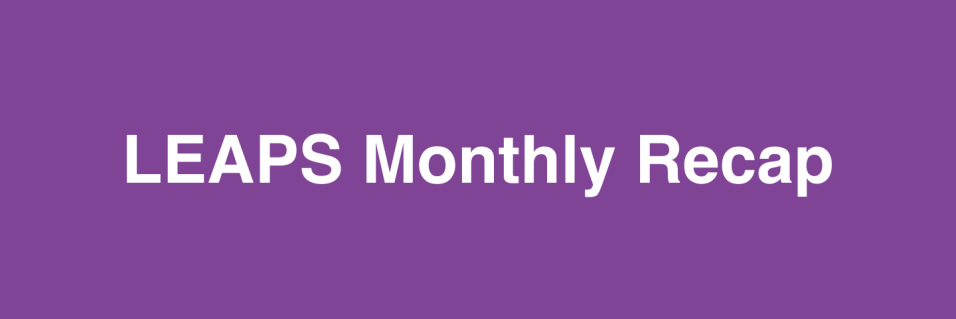NEW RESEARCH
Precision for whom? Partnering with patients to ensure that Precision Medicine targets what matters
Despite decades of growth and adaptation in patient engagement, knowing or being able to find guidance for which model or approach will be most impactful in which healthcare or research context can be challenging. Our latest Research Brief explores how LEAPS could act as an incubator to advance “precision patient engagement” for Precision Medicine.
IDEAS INTO ACTION
LEAPS seeking nominations for Predictive Outcomes Platform use case
The LEAPS Project of the MIT NEWDIGS initiative is actively soliciting Use Cases for our workstream focused on methods innovation associated with “Integrating Evidence Using Meta-Analytic Approaches.” This methodology is critical for the successful design, implementation, and scale-up of a novel Predictive Outcomes Platform (POP) now under development by the LEAPS community with the goal of improving patient outcomes in economically sustainable ways.
The Predictive Outcome Platform was conceptualized to address the need for a new capability for identifying clinically meaningful patient sub-populations of a target disease, and the associated predictive features that support the targeted use of drug therapy treatment regimens for optimal treatment outcomes. The platform will enable iterative cycles of predictive analytics applied by a network of federated evidence generation partners and coordinated by a neutral, centralized third party. It will be designed to scale efficiently, leveraging the sharing of evidence rather than patient-level data to refine the emergent predictive models.
Use Cases can come from any therapeutic area, though strong proposals focused on Rheumatoid Arthritis may be prioritized over others as we remain eager to leverage our work to date in this area. Key requirements for a use case include that the question being asked is predictive, it has real-world clinical importance, and it is relevant to multiple stakeholders.
Please download the Request for Use Case Nominations and the Nomination Form for a Use Case to advance our mutual priorities here! The deadline for submissions is October 15, 2021.
EVOLVING STRATEGY
Rebranding: Adaptive Reimbursement is now Precision Reimbursement
Adaptive Reimbursement evolved as a collaboration of our NEWDIGS LEAPS and FoCUS Projects. The goal of LEAPS is to advance the knowledge and practice of Precision Medicine by modernizing how we Plan, Produce, and Use real-world evidence (RWE) and the goal of FoCUS, with its Precision Financing tools, is to collaboratively ensure patient access to durable and potentially curable therapies using innovative financing and reimbursement solutions that also enhance sustainability for all stakeholders. By combining the expertise of these two communities, we are able to address the need for these new financing and payment approaches while also progressively strengthening the availability and use of RWE for treatment optimization.
Why the name change?
The word “adaptive” has caused some confusion among some who think we are talking about Bayesian approaches and adaptive clinical trials/platforms, as in the LEAPS Adaptive Point of Care (APoC) platform. In contrast, “precision” reflects targeting and matching, and the matching of payment to targeted groups with variable payments is a key part of this workstream.
Just as Precision Medicine seeks to counteract the “one size fits all” approach to healthcare by targeting the right treatment to the right patient at the right time, Precision Reimbursement (PR) acknowledges that there is no “one size fits all” approach to reimbursement tools or contracts, and no singular approach to how RWE is used. While a Payer, for example, can “adapt” from track-and-pay models to performance-based contracts, we believe there is a step further in the evolution by tapping into underutilized RWE to identify sub-populations for drug regimen improvement that could further refine those agreements in a more precise way, and even predict how future treatments in the pipeline might be handled.
PR structures align incentives across all stakeholders to achieve these goals in scalable, sustainable ways. PR pilots will be designed to optimize collaboration value via generalizable learnings while supporting the organizational autonomy pilot partners need to tailor specific design elements for successful implementation within their business environment.
An invited manuscript that provides an in-depth description of the evolution of Precision Reimbursement payment approaches through the lens of LEAPS and FoCUS is now under review by Clinical Pharmacology and Therapeutics.
For more information on Precision Reimbursement, or to join one of the associated working teams, please contact Azrina Azhar (azrina@mit.edu).
SAVE THE DATE
While we had hoped to convene in person, circumstances force us to meet virtually for our next Design Lab, where the two days will focus on the two pillars of innovation defined through the June 2021 Design Lab: Use of RWE (Precision Reimbursement Pilots, see “Rebranding…” above) and Production of RWE (Predictive Outcomes Platform). We are excited to get your input on our rapidly evolving Precision Reimbursement Pilots in Lipid Management and NGS Testing in Oncology, as well our initial prototyping of the Predictive Outcomes Platform focused on Integrating Evidence Use Cases (see “LEAPS seeks…” above) and work.
